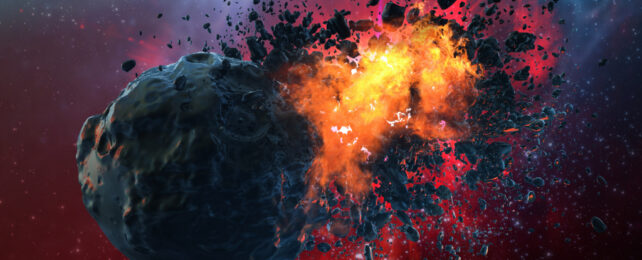Precise detonation of a nuclear bomb above an incoming chunk of space rock could be our best hope of avoiding a cataclysmic impact.
A laboratory experiment conducted by an international team of researchers has confirmed that the X-rays emitted by a suitably-sized atomic blast could shunt asteroids around 3 to 5 kilometers wide (around 2 to 3 miles) off their course.
While there's no evidence of a pressing need for such an anti-doomsday device, the consequences of being blindsided by a hazardous near-Earth asteroid aren't trivial, making it vital we come up with a game plan that's guaranteed to save our skins.
NASA recently demonstrated that if a heavy probe bumps a relatively petite pile of rock with enough force, it should steer clear of an impact with Earth.
At just a little under 800 meters across and consisting of loose-bound gravel and boulders, the smaller member of the binary Dimorphos and Didymos system shifted far enough in its orbit to make astrophysicists confident a directed collision could be used to nudge similar-sized objects onto less dangerous trajectories.
As promising as the results are, it's also clear we need a lot more data before we can go throwing chunks of metal at any old asteroid in the hopes it might avert disaster. A larger, more solid rock could be a whole other story.
Luckily there's more than one way to kick a mountain across the sky. Coupling it with a powerful fusion engine might work, for example, or using a focused laser to create a rocket effect by ablating the asteroid's surface.
Of the more feasible approaches, warming a small patch of an asteroid's surface with an intense glow of radiation could also create a rocket effect, vaporizing minerals with such ferocity the escaping gasses could, in theory, push the mass just enough to alter its path.
The basic principles behind evaporating rock with electromagnetic radiation can be tested and fine-tuned for different materials and mineral structures right here on Earth.
Led by Nathan Moore, a physicist at Sandia National Laboratories in the US, researchers used a high frequency electromagnetic wave generator called the Z Pulsed Power Facility to squeeze 1.5 megajoules of X-rays out of a tank of argon gas.
This 'bubble' of radiation obliterated a thin piece of metal foil holding aloft a grain of quartz or fused silica, leaving the sample hovering in freefall just long enough to resemble a tiny asteroid drifting through space.
A fraction of a second later, the X-ray pulse washed over the target, stripping micrometers from its surface and generating shock waves that provided essential data.
This could be used to predict the effects of a significantly larger burst of X-rays out in the interplanetary vacuum. In fact, the resulting transfer of momentum implies asteroids as large as 5 kilometers across could plausibly be moved using this approach.
"More detailed models, such as the radiation-hydrodynamic model illustrated here and those in other studies can be tested against experimental data acquired with this technique and used to refine the predictions for different asteroid intercept missions," the team notes in its report.
Of course, asteroids are made of more than these two materials, often including a mix of volatiles piled in a variety of ways. Using the same approach, each potential scenario could be tested without needing to put together expensive missions and waiting years to analyze the results.
Ideally, it's knowledge we will never need. Though a handful of city-killer asteroids are predicted to come within a cosmic whisker of Earth, nothing on the map promises to strike any time soon.
Still, nobody likes surprises. Should a bullet with our name on it come whizzing out of the darkness, we should know exactly how to bake it back into oblivion.
This research was published in Nature Physics.
